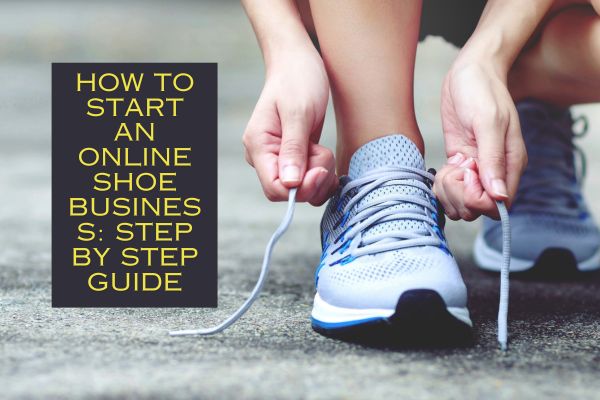Starting an online shoe business can be a rewarding venture, but it requires careful planning and execution. With the right strategy, a dash of creativity, and a sprinkle of determination, you can make your mark in the vast and stylish world of footwear. In this comprehensive guide, we’ll walk you through each step, from conceptualizing your brand to launching your virtual storefront.
How to Start an Online Shoe Business: A Step-by-Step Guide
1. Finding Your Niche
Before you start sketching out business plans, it’s crucial to identify your niche. What makes your shoe business stand out in a sea of sneakers? Do you specialize in sustainable footwear, or are you the go-to place for funky, avant-garde designs? Your niche defines your brand, so put on your thinking cap and brainstorm! Here are some steps to help you discover your niche:
- Explore Trends: Dive into the world of fashion and footwear to identify emerging trends. Are chunky sneakers making a comeback, or is it all about sleek, minimalist designs?
- Know Your Audience: Who are you targeting? Athletes, fashionistas, eco-conscious consumers? Understanding your audience helps tailor your shoe selection to their preferences.
- Unique Selling Proposition (USP): What sets your shoes apart? Whether it’s innovative materials, exclusive collaborations, or unmatched comfort, your USP is your secret weapon
- Identifying Market Gaps: Understanding your target audience and finding untapped market niches can set the foundation for a successful online shoe business.
- Researching Trends: Stay ahead of the curve by researching current shoe trends. Incorporating popular styles into your offerings can attract a broader customer base.

2. Building Your Brand
Your brand name is more than just a label; it’s the face of your business! So, choose wisely. Here’s how to make sure your brand name kicks:
- Memorability: Is it easy to remember? Avoid tongue twisters or obscure references that only you get.
- Relevance: Does it reflect your niche and personality? A name that resonates with your audience is a winner.
- Availability: Check domain availability for your brand name. You want a website that matches your brand!
- Crafting a Unique Value Proposition: Define what sets your online shoe business apart. A compelling value proposition will resonate with customers and build brand loyalty.
- Designing a Memorable Logo: Your logo is the face of your brand. Invest time in creating a visually appealing and memorable logo that reflects your brand identity.
3. Setting Up Your Online Store
- Choosing a Platform: Selecting the right e-commerce platform is crucial. Evaluate options like Shopify, WooCommerce, or Magento based on your business’s specific needs.
- Creating a User-Friendly Interface: Design an intuitive and user-friendly website. Ensure easy navigation, seamless checkout processes, and mobile responsiveness.

4. Sourcing Quality Products
It’s time to fill those virtual shelves with the hottest kicks in town! Here’s how to source the best inventory for your online shoe business:
- Connect with Suppliers: Reach out to manufacturers, wholesalers, or even local designers. Building strong relationships ensures a steady supply of quality footwear.
- Quality Control: Don’t compromise on quality. Your reputation hinges on delivering top-notch products.
- Stay Trendy: Keep an eye on fashion forecasts. What’s hot today might be yesterday’s news tomorrow!
- Building Relationships with Suppliers: Establish strong relationships with reliable suppliers to ensure a consistent flow of quality products for your online shoe store.
- Considering Customization Options: Offering customization options can attract a niche market. Explore opportunities to allow customers to personalize their shoe purchases.
5. Implementing Effective SEO Strategies
If you want your online shoe business to strut to the top of search engine rankings, sprinkle some SEO magic into your content. Identify keywords (like “How to start an online shoe business and the steps involved”) and lace them seamlessly into your website’s copy. Google loves a well-optimized site, and your customers will love finding you effortlessly.
- Keyword Research: Identify relevant keywords for your shoe business. Use tools like Google Keyword Planner to optimize your product listings and website content.
- Optimizing Product Descriptions: Craft compelling product descriptions with a focus on both SEO and engaging storytelling. Highlight key features and benefits to entice potential customers.
6. Marketing Your Online Shoe Business
You’ve got the shoes; now, let’s get the world talking about them! Marketing is the lifeline of your online shoe business. Here’s how to make a splash:
- Social Media Presence: Leverage the power of Instagram, Facebook, and Twitter. Share captivating visuals, engage with your audience, and run targeted ads. Build a strong social media presence to connect with your audience and showcase your products.
- Influencer Collaborations: Partnering with influencers in the fashion industry can amplify your brand’s visibility. Choose influencers whose audience aligns with your target market.

7. Providing Excellent Customer Service
- Responsive Communication: Respond promptly to customer inquiries and feedback. Positive interactions can lead to repeat business and positive word-of-mouth.
- Easy Returns and Exchanges: Implement a hassle-free return and exchange policy. This builds trust with customers and encourages them to make purchases without hesitation.
8. Analyzing and Adapting
- Utilizing Analytics Tools: Regularly analyze website traffic, sales data, and customer behavior using analytics tools. Use insights to make informed business decisions.
- Staying Adaptive: The online market is dynamic. Stay abreast of industry trends, and be ready to adapt your strategies to stay competitive.
Navigating the Online Shoe Business Landscape: Essential Prerequisites for Success
In the dynamic realm of e-commerce, the online shoe business has emerged as a lucrative venture, driven by the ever-growing demand for footwear in the digital age. Whether you are a seasoned entrepreneur or a budding startup, stepping into the online shoe market requires careful consideration of various prerequisites to ensure a successful and sustainable business. In this comprehensive guide, we will delve into the key elements and strategies that form the foundation of a thriving online shoe business.
1. Market Research: Understanding the Footwear Landscape
Before embarking on the journey of establishing an online shoe business, it’s imperative to conduct thorough market research. Analyzing market trends, consumer preferences, and competitor strategies will provide valuable insights. Identify niche segments within the footwear market and assess the demand for specific types of shoes, such as athletic, casual, or formal wear. This knowledge will guide your product selection and marketing efforts.
2. Building a Robust E-commerce Platform: The Digital Storefront
A user-friendly and visually appealing e-commerce website is the cornerstone of a successful online shoe business. Invest in a reliable e-commerce platform that offers seamless navigation, secure payment gateways, and mobile responsiveness. Optimize the website for search engines to enhance visibility. High-resolution images, detailed product descriptions, and intuitive filters will contribute to a positive user experience, encouraging repeat visits and conversions.
3. Curating a Diverse Product Catalog: Meeting Varied Consumer Needs
Diversify your product catalog to cater to different customer preferences. Include a range of shoe styles, sizes, and colors to accommodate a broad audience. Collaborate with reputable brands or explore opportunities for private labeling to establish a unique selling proposition. Regularly update your inventory to stay in tune with fashion trends and seasonal demands, ensuring that your online store remains a one-stop destination for shoe enthusiasts.
4. Inventory Management System: Ensuring Stock Availability
Efficient inventory management is crucial for preventing stockouts or overstock situations. Implement a robust inventory management system that tracks stock levels, alerts for restocking, and facilitates seamless order fulfillment. This not only enhances customer satisfaction but also prevents revenue loss due to missed sales opportunities or excess inventory.
5. Seamless Customer Experience: From Browsing to Purchase
Provide a seamless customer journey from product discovery to checkout. Implement an intuitive and secure online shopping cart system. Offer multiple payment options, including credit cards, digital wallets, and other popular methods. Incorporate a responsive customer support system to address inquiries and concerns promptly. A positive customer experience fosters loyalty and encourages word-of-mouth marketing.
6. Effective Digital Marketing: Boosting Visibility and Sales
Crafting a robust digital marketing strategy is essential for driving traffic to your online shoe store. Leverage search engine optimization (SEO) techniques to enhance your website’s visibility on search engines. Engage in content marketing through blogs, social media, and email campaigns to build brand awareness. Collaborate with influencers or run targeted online ads to reach a wider audience. Balancing burstiness in marketing campaigns can create spikes in interest and sales.
7. Implementing Analytics: Data-Driven Decision Making
Utilize analytics tools to gather data on website performance, customer behavior, and sales trends. Analyzing this data empowers you to make informed decisions, refine your marketing strategies, and optimize the user experience. Regularly review key performance indicators (KPIs) such as conversion rates, bounce rates, and customer acquisition costs to identify areas for improvement and capitalize on successful initiatives.
8. Securing Logistics and Fulfillment Partners: Timely Deliveries Matter
Establishing reliable logistics and fulfillment partnerships is crucial for timely order deliveries. Collaborate with reputable shipping carriers to ensure accurate and secure transportation of products. Implement an efficient order fulfillment process to minimize delivery times, enhancing customer satisfaction and building a positive reputation for your online shoe business.
9. Legal Compliance: Navigating Regulations
Adhering to legal requirements is paramount in the online business landscape. Ensure compliance with e-commerce regulations, data protection laws, and taxation requirements. Clearly outline your business policies, including shipping, returns, and privacy policies, to build trust with customers and avoid potential legal issues.
10. Continuous Innovation and Adaptation: Staying Ahead of the Curve
The online shoe business is dynamic and ever-evolving. Stay attuned to industry trends, technological advancements, and customer feedback. Embrace innovation, whether it’s through introducing new product lines, adopting emerging technologies like augmented reality for virtual try-ons, or enhancing your website’s features. Adaptability is key to staying competitive in the fast-paced world of online retail.
Launching and sustaining a successful online shoe business requires a strategic approach that encompasses market understanding, digital presence, customer-centric practices, and adaptability. By addressing these prerequisites with a focus on perplexity and burstiness in your strategies, you can position your online shoe business for long-term success in the competitive e-commerce landscape.
Unlocking Success: Understanding What Customers Truly Want From Your Online Shoe Business
In the vast landscape of online retail, the success of your shoe business hinges on more than just offering a variety of footwear. To truly thrive, it’s imperative to comprehend and fulfill the desires of your customers. Leinto the key aspects of what customers are seeking from an online shoe business, exploring the intricacies of their preferences and expectations.
1. Trendy and Diverse Selections: Catering to Style Preferences
One of the primary things customers crave from an online shoe business is a trendy and diverse selection. Footwear is not just a functional necessity; it’s a fashion statement. Ensure that your product catalog stays abreast of the latest style trends. From casual sneakers to formal loafers, having a broad array of options will cater to diverse tastes, making your online store a go-to destination for fashion-forward individuals.
2. Detailed Product Information: Empowering Informed Decisions
Customers appreciate transparency, especially when it comes to online shopping. Providing detailed product information is crucial for empowering customers to make informed decisions. Include comprehensive descriptions, sizing guides, and high-resolution images for each shoe. This not only reduces the likelihood of returns but also enhances customer trust, as they can confidently select the footwear that suits their preferences and needs.
3. User-Friendly Website: Seamless Navigation and Intuitive Design
The online shopping experience begins with your website, and customers expect it to be seamless and user-friendly. Invest in an intuitive design that allows for easy navigation. Implement clear categories, effective search functionality, and filters to help customers quickly find the shoes they are looking for. A smooth and efficient website enhances the overall customer experience, increasing the likelihood of repeat business.
4. Personalized Recommendations: Enhancing the Shopping Journey
In the era of personalization, customers appreciate tailored recommendations that align with their preferences. Implement algorithms that analyze customer behavior and purchase history to offer personalized suggestions. This not only adds a personalized touch to the shopping experience but also encourages customers to explore and discover new styles, increasing the chances of upsells and cross-sells.
5. Hassle-Free Returns and Exchanges: Building Trust
A robust return and exchange policy is a vital component of customer satisfaction. Customers want the assurance that if the shoes don’t fit or meet their expectations, the process of returning or exchanging them will be hassle-free. Clearly communicate your return policy, and make the process as straightforward as possible. Building trust in this aspect fosters loyalty, as customers feel confident in their ability to rectify any issues.
6. Competitive Pricing and Discounts: Value for Money
While quality is paramount, customers are also price-conscious. Offering competitive pricing and occasional discounts or promotions can be a powerful incentive. Consider bundling options, loyalty programs, or seasonal sales to provide customers with value for their money. This not only attracts new customers but also keeps existing ones returning for more.
7. Responsive Customer Support: Addressing Concerns Promptly
Exceptional customer support is non-negotiable. Customers want to know that if they encounter any issues or have questions, there is a responsive and helpful team ready to assist. Implement live chat, email support, and a comprehensive FAQ section to address common queries. Swift and effective communication builds a positive rapport with customers, contributing to a positive brand image.
8. Secure and Convenient Payment Options: Prioritizing Customer Convenience
The online shopping landscape demands secure and convenient payment options. Ensure that your online shoe business accepts a variety of payment methods, including credit cards, digital wallets, and other popular choices. Implementing a secure payment gateway adds an extra layer of trust, assuring customers that their financial information is handled with the utmost care.
9. Social Proof and Reviews: Building Credibility
Customers often seek the opinions of their peers before making a purchase. Encourage and showcase customer reviews and testimonials on your website. Actively engage with customers on social media platforms, sharing user-generated content and creating a sense of community around your brand. Positive social proof builds credibility and helps potential customers feel more confident in choosing your online shoe store.
10. Sustainable and Ethical Practices: Meeting Conscious Consumerism
In an era of heightened environmental and social awareness, customers increasingly value businesses that embrace sustainable and ethical practices. Consider incorporating eco-friendly materials in your shoe designs, and communicate your commitment to ethical manufacturing processes. This not only attracts a growing segment of conscious consumers but also aligns your brand with values that resonate with a broader audience.
Conclusion
In conclusion, the success of your online shoe business rests on your ability to understand and meet the evolving expectations of customers. By offering a diverse selection, transparent information, personalized experiences, and prioritizing customer satisfaction at every touchpoint, your online shoe business can not only meet but exceed customer expectations, creating a loyal customer base in the competitive world of e-commerce.
Starting an online shoe business is a challenging but rewarding journey. By finding your niche, building a strong brand, optimizing your online store, sourcing quality products, implementing effective SEO strategies, and focusing on customer service, you can create a thriving online presence in the competitive world of e-commerce.
FAQs
- What e-commerce platform is best for a small online shoe business? Choose a platform like Shopify for its user-friendly interface and scalability, ideal for small businesses.
- How can I identify untapped market niches for my shoe business? Conduct thorough market research, analyze customer needs, and look for gaps in the current offerings.
- Why is a unique value proposition important for my online shoe business? It sets your brand apart, helping customers understand what makes your products different from others in the market.
- How often should I update my product listings for SEO purposes? Regularly update product listings to reflect current trends and ensure optimal SEO performance.
- Is it necessary to partner with influencers to market my shoe business? While not necessary, influencer collaborations can significantly boost your brand visibility and reach a wider audience.






